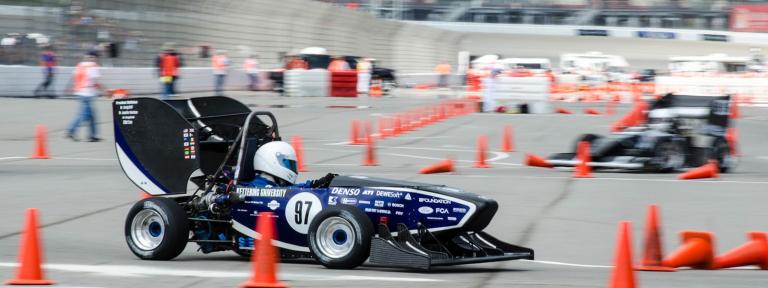
In printed form, the page count reaches 125. But most teams are undaunted by the size of the rules publication, even if team engineers do not enjoy reading. By all accounts, Formula SAE teams throughout the world generally have a good understanding of the competition rules for each year and don't require tutorials to read about new changes as they work toward designing this year's race cars.
But one rule for 2006 is a little more complex and could undergo clarification, according to Dr. Craig Hoff, an associate professor of Mechanical Engineering, adviser for Kettering's Formula race team, and a member of the Formula SAE rules committee. The rule is called the Impact Attenuator Data Requirement and the basic issues teams face include "how to design a race car's crash zone on the front end to meet the new criteria," Hoff said. "Since our University now has the Crash Safety Center up and running, we thought testing our race car for this rule would present a great opportunity for both Kettering and the SAE."
Hoff was correct. On Friday, Jan. 20, tests began in Kettering's Crash Safety Center. Although the SAE did not commission these tests, Hoff decided to engage in them as a professional courtesy to insure that teams properly design their cars to protect drivers during competitions.
Dr. Janet Brelin-Fornari agrees with Hoff that this testing is a unique opportunity for SAE teams and for the center. As an associate professor of Mechanical Engineering and director of the Center, this testing touches upon an important new area of crash safety study. "This really is a first for Kettering," she said. "This testing will benefit all Formula SAE teams by fully explaining the new rule based on real testing, which will help teams design cars accordingly," she added. Fornari also noted that instrumentation provided by R.A. Denton of Rochester Hills, Mich., played an important role in this testing.
In a nutshell, the Impact Attenuator Data Requirement requires teams to submit calculations and/or test data to show a team's impact attenuator would give an average deceleration of 20 g. following a collision. Teams will mount the attenuator-a device that absorbs energy in a collision-on the front end of their Formula race car, which must weigh no more than 300 kilograms (or 661 pounds), and run the vehicle into a solid, non-yielding impact barrier with a velocity of impact of 7.0 metres.
For Hoff, making sure to interpret the rule correctly meant extending tests based on wide range of speeds. "The SAE rules committee is certainly concerned about the potential for injury and this is one reason why we're running this test and checking vehicles during the design phases of competitions in 2006 for this requirement," he said. "We ran our tests using the 7.0 metres/second criteria, which is about 15 miles-per-hour (mph), and found that the potential for injury was very low. Out of curiosity, we also ran the tests at higher speeds and found that a crash at 35 mph into a solid barrier had the potential for serious injury."
Several SAE student team members participated in this testing: Nick Vernon, a senior from Schoolcraft, Mich., who manages sponsorship opportunities for the team and such engineering duties as controls; Senior Jason Kane from Cadillac, Mich., Dave Rising, a senior from Tacoma, Wash., who looks after other engineer and design-related efforts; and senior Joe Adkins.
Overall, Hoff and Fornari are pleased with tests thus far and hope results will go a long way in providing other teams clarification about how to meet the Impact Attenuator Data Requirement criteria as develop their competition schedules. "We're fortunate to have this center at Kettering, especially since we can involve students in the testing," Hoff said, adding, "it's a perfect chance to expose them to other forms of engineering, one critical to the automotive industry."
For more information about Kettering University's Crash Safety Center, contact Dr. Janet Brelin-Fornari at (810) 762-7843.
Written by Gary J. Erwin
(810) 762-9538
gerwin@kettering.edu